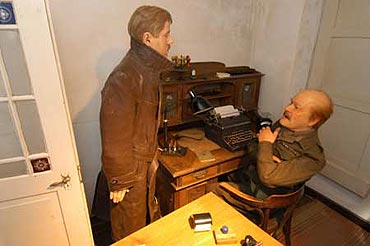Schrift: größer/kleiner
Inhaltsverzeichnis
Sie sind hier: WirRheinländer > english version > The Exhibition > Scenes > Denazification office
Denazification office

In addition to demilitarization and democratization, it was the task of the Allies to dismantle and denazify Germany. Public institutions were the first to be "cleansed" of supporters of national socialism (Nazism). The procedure differed from zone to zone. Most of the proceedings were held in the US zone in a very strict way, whereas the British military authorities gave priority to good administration above political cleansing. Logically this meant that numerous civil servants of the Third Reich were reemployed by the occupying powers and later in the new West German state. When the Cold War began, interest waned in pursuing such action. In March 1948 denazification was abandoned without having prosecuted any high-ranking guilty persons. Up until then the majority of cases tried had been minor. This led to criticism that "the little minnows get hanged, but the big fish are allowed to escape", which significantly burdened the foundation of the new Federal Republic.
The Potsdam Agreement of August 1945 served as the basis for denazification. The victorious powers declared:
"All members of the Nazi party who took part in more than a nominal capacity, and all other persons who are hostile to the objectives of the Allies, are to be expelled from semi-public or public office. These persons must be replaced by people who, in accordance with their political and moral character, appear to be capable of developing truly democratic institutions in Germany."
(Abkommen von Potsdam, August 1945, Politische Grundsätze. Amtsblatt des Kontrollrates in Deutschland. Ergänzungsblatt Nr. 1, S. 13-20)


